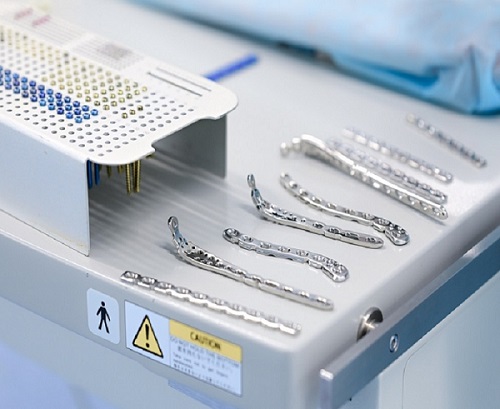
The Future of Orthopaedic Implants: Trends and Innovations
Orthopaedic implants have played a crucial role in modern medicine, helping millions of patients regain mobility and improve their quality of life. With continuous advancements in medical technology, the future of these implants looks promising, offering better durability, enhanced biocompatibility, and innovative features. In this blog, we explore the latest trends and innovations shaping the future of orthopaedic implants.
1. 3D Printing and Customization
One of the most significant advancements in orthopaedic implants is the use of 3D printing technology. This innovation allows for the creation of patient-specific implants that fit perfectly with an individual's anatomy. Customization improves implant integration, reduces surgical time, and enhances overall patient outcomes. Additionally, 3D printing minimizes material wastage and lowers production costs, making high-quality implants more affordable and accessible. This technology is also beneficial in designing Small Fragment Locking Plates and Mini Fragment implants tailored for specific needs.
2. Smart Implants with IoT Integration
The rise of the Internet of Things (IoT) has led to the development of smart orthopaedic implants equipped with sensors that monitor real-time data. These implants can track healing progress, detect infections, and send alerts to healthcare providers, ensuring proactive patient care and reducing complications. By integrating with mobile applications, patients and doctors can access real-time information, allowing for remote monitoring and timely intervention if needed. ACL-PCL Implants are among the evolving technologies benefiting from smart implant solutions.
3. Bioactive and Biodegradable Materials
Traditional implants are often made of metal or ceramic, but newer materials such as bioactive coatings and biodegradable polymers are emerging. Bioactive implants promote bone growth and integration, ensuring a stronger bond with the natural bone. Biodegradable implants, on the other hand, gradually dissolve as the bone heals, eliminating the need for removal surgeries. This innovation is particularly beneficial for pediatric patients, as their bones continue to grow and develop. Cannulated Cancellous Screw and DHS - DCS & Angled Blade implants are also evolving with these materials to enhance healing processes.
4. AI and Robotics in Surgery
Artificial Intelligence (AI) and robotic-assisted surgery are transforming the way orthopaedic implants are placed. AI-driven planning helps surgeons determine the optimal implant size and position, enhancing surgical precision. Robotics-assisted surgery further improves accuracy, reducing the risk of complications and improving long-term success rates. AI-powered predictive analytics also help in assessing patient risks and personalizing treatment plans. The integration of AI has been particularly beneficial in procedures involving Hip Prosthesis and Intramedullary Nail placements.
5. Advancements in Surface Coatings
New surface coating technologies are being developed to improve the longevity and performance of implants. Antibacterial coatings help prevent post-surgical infections, a major concern in orthopaedic procedures. Nanotechnology-based surfaces promote better osseointegration, leading to faster healing and improved implant stability. These coatings also enhance wear resistance, extending the lifespan of the implants and reducing the need for revision surgeries. Large Fragment and Maxillofacial Implants are benefiting significantly from these advancements.
6. Regenerative Medicine and Stem Cell Therapy
Regenerative medicine is another exciting frontier in orthopaedics. Researchers are exploring stem cell therapy and tissue engineering to develop implants that not only replace damaged structures but also stimulate natural tissue regeneration. This breakthrough could eventually lead to self-healing implants that integrate seamlessly with the body. Such implants could significantly reduce the dependency on traditional materials and promote faster recovery for patients with severe injuries or degenerative conditions. Pins, Wires & Staples are also being incorporated with regenerative solutions for enhanced healing.
7. Personalized Orthopaedic Solutions
Advancements in genetic mapping and AI-driven diagnostics are paving the way for highly personalized orthopaedic solutions. By analyzing a patient's genetic composition and bone structure, medical professionals can recommend implants that are tailored to individual needs, reducing the risk of complications and ensuring optimal results. Personalized implants also lower the chances of implant rejection and enhance long-term performance. Spinal Implants, External Fixators, and Radial Implants are some of the key products being designed with these cutting-edge advancements.
Conclusion
The future of orthopaedic implants is driven by innovation, ensuring improved patient outcomes, reduced recovery times, and enhanced durability. From 3D printing and smart implants to bioactive materials and AI-assisted surgery, these advancements are revolutionizing the field of orthopaedics. If you are looking for high-quality Orthopaedic Implants, explore our premium range at GWS Surgicals. Our selection includes Orthopaedic Sets designed for precision and efficiency.
As technology continues to evolve, orthopaedic implants will become more efficient, personalized, and accessible, transforming the way musculoskeletal conditions are treated worldwide.
Leave a Comment
© Copyright © 2024 gwsmed.com | GWS Surgicals LLP. All rights reserved.
| |




Comment (0)
No Comments Yet. Be the first one.